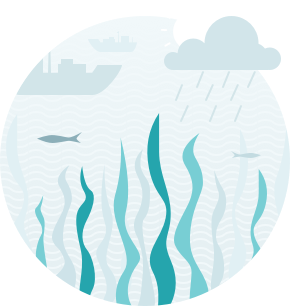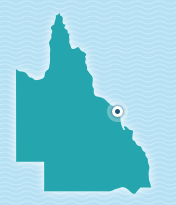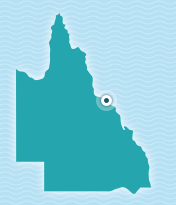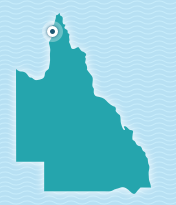Seagrass monitoring

Seagrasses are a critical coastal marine habitat and a key indicator of overall marine health. In one of our longest running environmental programs, North Queensland Bulk Ports surveys over 30,000 hectares of seafloor across our four ports.
Partnering with scientists at James Cook University (JCU), NQBP has been collecting data on seagrass growth around our port sites for more than 20 years.
Because we've monitored for so long and so broadly, our seagrass data has become an invaluable resource that enables us to track distribution, density and seasonality, establish naturally occurring fluctuations and determine how external factors may potentially impact these important communities.
In addition to informing our own environmental activities and port operations, our data has contributed to advances in an international body of seagrass knowledge through JCU's academic research and regional report cards developed to help monitor the health of our waterways.
-
The map below shows the historical extent of seagrass presence within our monitoring areas over the past ten years. The program for the Hay Point and Mackay region has recently been transitioned to a three-year cycle, completing a large survey of inshore/coastal and offshore areas every three years and smaller surveys in the intervening years.
Like most plants, seagrass responds to changes in its surrounding environment. So we also keep track of environmental influencers such as light and temperature that may impact the distribution and condition of seagrass growing in our monitoring areas.
Many environmental influencers and events can impact the marine ecosystem. Major weather events that are particularly relevant in North Queensland are cyclones.
Cyclones typically generate extreme energy environments, with large waves and intense winds, both of which can have a strong physical impact on seagrass and their seed banks within the sediments such as burial, scouring, or direct removal of plants or seeds. Secondary impacts caused by associated high rainfall—such as changes in salinity, turbidity and nutrient levels during or leading up to the growing season—may also affect the seagrass.
The boundary of the offshore area for the Hay Point and Mackay region has changed over time however to allow comparison of all years’, the map and graphical comparisons are based on the 2004 delineated survey area. Further detail on this can be found in these reports.
Environmental influencers --
Higher water temperatures can make it difficult for seagrass to grow. A prolonged period of time of high water temperatures during the growing season, as well as an above-average water temperature for the year, can indicate pressure on coastal seagrass condition.
Water temperature over 10 years -
Solar radiation is a way of measuring the intensity of the sun as it falls on the water surface. High solar radiation may offer benefit to seagrasses by providing more energy for photosynthesis. However, when this is coupled with extended periods of high water temperature or extended periods of daytime exposure to air at low tide, we are, likely to see seagrass come under increased pressure (see below for density charts).
Solar radiation over 10 years -
As seagrasses need light to survive, they are sensitive to any pressures that may reduce the light available to them. High rainfall can lead to increased runoff from the land, turbid water flows into coastal environments and local coastal re-suspension that result in reduced levels of light reaching the ocean floor making it difficult for seagrasses to survive. In extreme cases high rainfall and flooding can also reduce the salinity of the water which may also cause stress to seagrasses.
Rainfall over 10 years
 Seagrass extent
Seagrass extentThe chart to the right shows the annual seagrass extent as a percentage of our total inshore survey area.
The location of these inshore seagrasses means that they are susceptible to environmental pressures such as high rainfall, flood plumes and high wave/wind activity. These communities are generally dominated by Holodule uninervis with Halophila ovalis and Zostera muelleri also being identified in the area. H. uninervis and Z. muelleri are more stable and persistent than other, more colonising species.
As you can see, the region has had a large number of cyclone events in the period. In the past 10 years, the highest coverage of seagrass in inshore areas of Hay Point and Mackay was in 2010 at just under seven percent, however, it has more commonly been recorded at below two percent. You may notice the reduction in seagrass extent found in instances where a growing season follows a cyclone event.
Only recently the Hay Point and Mackay program transitioned to the three-year cycle referenced above which is why you will note that some of our earlier surveys are not completed on an annual basis for inshore areas.
Seagrass densitySeagrass density can be an important indicator of the health of a seagrass community. Denser seagrass communities can provide more complex habitat structure and protection for animals that use them as nursery grounds, and may also provide more food for turtles, dugongs and other marine animals.
In our monitoring areas, density is a representation of the above ground biomass of seagrass within each monitoring area.
As this is measured primarily using a “visual estimates of biomass” technique (Kirkman 1978; Mellors 1991), poor visibility during the survey can compromise the ability to obtain results. This is evidenced in the chart on the right, which shows annual data for each year when density surveys have been able to be completed.
Compared to the long-term average, inshore seagrasses have recorded moderate densities for majority of years, with the 2016 year boosting density to high. Recently numerous turtles have been spotted feeding amongst these inshore seagrass communities demonstrating that while meadow size is small, these inshore seagrasses continue to offer an important function to our local marine environment.
The above chart shows the extent of seagrass to not be overly impacted by the 2017 cyclone, while the density chart on the right provides more insight into the potential effects of this event.
High levels of solar radiation and daytime exposure to air at low tide can also affect density, as it may cause the seagrasses to experience temperature stress or leaves to burn.
You can see more analysis on the data in these reports. You can also download the data used to create this chart.
Seagrass growthThe chart to the right shows data only from the years when the larger surveys of deep water, offshore seagrass have been conducted; at least every three years. It shows seagrass extent as a percentage of our total offshore survey area.
The deepwater seagrasses offshore from the ports of Hay Point and Mackay are dominated by fast growing colonizing species Halophila decipiens and H. spinulosa. These seagrasses are highly seasonal and generally only present in the period between July and December. Similar to annual land plants, they are known to have an annual programmed seasonal die off and recruit the following year from seeds.
In the past 10 years, the highest coverage of seagrass within the surveyed offshore areas of the Hay Point and Mackay region was in 2014 at just under 45 percent. However, it has more commonly been recorded at less than 20 percent. The dominance of colonising species means that impact to the seedbank may have lasting effects on the capacity for the seagrass to regenerate each year.
You may notice the reduction in seagrass extent found in instances where a growing season follows a cyclone event. As you can see, the region has had a large number of cyclone events over the period. While the occurrence of cyclones during the growing season will impact the extent of growth that year, instances where cyclones occur during senescent periods may impact future year’s seagrass extent where these events cause the seed bank to be stripped.
Seagrass densitySeagrass density can be an important indicator of the health of a seagrass community. Denser seagrass communities can provide more complex habitat structure and protection for animals that use them as nursery grounds, and may also provide more food for turtles, dugongs and other marine animals.
In our monitoring areas, density is a representation of the above ground biomass of seagrass within each monitoring area.
As noted above, these deepwater seagrasses are known to be ephemeral in nature – meaning that they have a programmed seasonal pattern of growth between July and December followed by senescence, relying on a seed bank to flourish again each year.
As is shown in the chart on the right, these offshore seagrasses are living at the margins of their natural environmental tolerances in this region and therefore consistently record low densities.
You can see more analysis on the data in these reports. You can also download the data used to create this chart.
Seagrass growthThe Keswick Island monitoring area encompasses Keswick Island and the adjacent St Bees Island. This area was added to the program in 2014 and the chart to the right shows data collected since this time. It shows seagrass extent as a percentage of our total Keswick Island survey area.
The seagrass communities of the Keswick Island monitoring areas are dominated by the fast growing colonising species Halophila tricostata with occasional presence of H. decipiens.
The highest coverage of seagrass within the surveyed Keswick Island monitoring area was in 2017, at just over 35 percent. The offshore location of these seagrass meadows means that water quality often returns to favourable conditions after a significant weather event much sooner than their inshore counterparts. This makes them less susceptible to turbid coastal runoff and flooding from natural events such as cyclones and high rainfall.
Seagrass densitySeagrass density can be an important indicator of the health of a seagrass community. Denser seagrass communities can provide more complex habitat structure and protection for animals that use them as nursery grounds, and may also provide more food for turtles, dugongs and other marine animals.
In our monitoring areas, density is a representation of the above ground biomass of seagrass within each monitoring area.
Cyclones can cause a range of weather conditions that influence which species become dominant and therefore, affect density levels.
This chart shows annual data for every year when we have been able to conduct density surveys in the area.
As noted above, the offshore position of Keswick Island’s seagrass communities means that they are less susceptible to major water quality events from the mainland and therefore have shown generally stable area (extent) recorded in the above chart.
The density chart to the right, provides more insight into the potential effects of cyclonic events on these seagrasses, even where overall area (extent) is maintained or expanded.
You can see more analysis on the data in these reports. You can also download the data used to create this chart.
About the dataAll data presented on this page has been compiled using data collected by James Cook University on behalf of North Queensland Bulk Ports. Every effort has been made to ensure its accuracy; however, errors can occur. If you notice anything that looks incorrect, please feel free to contact us to let us know. We will always do our best to rectify any errors as soon as we are aware of them.
Seagrass surveys are conducted during every growing season and we aim to upload new seagrass data for the prior year by the second quarter of each subsequent calendar year.
-
-
The map below shows the historical extent of seagrass presence within our monitoring areas over the past ten years. The Abbot Point program has recently transitioned to a three-year cycle, completing a large survey of inshore/coastal and offshore areas every three years and smaller surveys in the intervening years.
Like most plants, seagrass responds to changes in its natural environment. So we also keep track of environmental influencers, such as light and temperature that may impact the distribution and condition of seagrass growing in our monitoring areas.
Many environmental influencers and events can impact the marine ecosystem. Major weather events that are particularly relevant in North Queensland are cyclones.
Cyclones typically generate extreme energy environments, with large waves and intense winds, both of which can have a strong physical impact on seagrass and their seed banks within the sediments such as burial, scouring, or direct removal of plants or seeds. Secondary impacts caused by associated high rainfall—such as changes in salinity, turbidity and nutrient levels during or leading up to the growing season—may also affect the seagrass.
Surveying of Abbot Point inshore seagrasses is focused on key dominant meadows, however for the purposes of the below graph comparisons and determining a percentage cover, the ‘inshore’ survey boundary area has been set at the mean sea level elevation of five metres. Further detail on the methods for monitoring can be found in these reports.
Environmental influencers --
Higher water temperatures can make it difficult for seagrass to grow. A prolonged period of time of high water temperatures during the growing season, as well as an above-average water temperature for the year, can indicate pressure on coastal seagrass condition.
Water temperature over 10 years -
Solar radiation is a way of measuring the intensity of the sun as it falls on the water surface. High solar radiation may offer benefit to seagrasses by providing more energy for photosynthesis. However, when this is coupled with extended periods of high water temperature or extended periods of daytime exposure to air at low tide, we are, likely to see seagrass come under increased pressure (see below for density charts).
Solar radiation over 10 years -
As seagrasses need light to survive, they are sensitive to any pressures that may reduce the light available to them. High rainfall can lead to increased runoff from the land, turbid water flows into coastal environments and local coastal re-suspension that result in reduced levels of light reaching the ocean floor making it difficult for seagrasses to survive. In extreme cases high rainfall and flooding can also reduce the salinity of the water which may also cause stress to seagrasses.
Rainfall over 10 years
 Seagrass extent
Seagrass extentThe chart to the right shows annual seagrass extent as a percentage of our total inshore survey area. These communities are generally dominated by Halophila ovalis, Zostera muelleri and Halodule uninervis.
Being in proximity to the flood plain discharge point of the Don River system, inshore seagrass communities within the Abbot Point region are particularly susceptible to high rainfall and flood plumes, as well as high temperatures and high wave and wind activity associated with cyclones.
Cyclones can present quite differently, with wind speed, trajectory and volume of associated rainfall all playing a key role in the potential impact on seagrasses. Tropical Cyclone (TC) Yasi in 2011 and TC Debbie in 2017 did not differ significantly in strength, however, associated rainfall, and resultant Don River discharge was much lower with TC Debbie. There was a marked difference in seagrass community area recorded in the years following each of these events.
Seagrass densitySeagrass density can be an important indicator of the health of a seagrass community. Denser seagrass communities can provide more complex habitat structure and protection for animals that use them as nursery grounds, and may also provide more food for turtles, dugongs and other marine animals.
In our monitoring areas, density is a representation of the above ground biomass of seagrass within each monitoring area.
As noted above, proximity to the Don River system discharge means that these seagrasses are particularly susceptible to high rainfall and flood plume events.
High levels of solar radiation and tidal exposure may also align with reductions in seagrass density due to photosynthetic stress from high temperatures and possible leaf burning.
While seagrass density is shown to be maintained in the moderate to high categories in the Abbot Point area, the variation between the years is primarily a product of changes in species composition from more persistent, larger stable species to smaller colonising species.
You can see more analysis on the data in these reports. You can also download the data used to create this chart.
Seagrass growthThe chart to the right shows data only from the years when the larger survey of deep water, offshore seagrass has been conducted. It shows seagrass extent as a percentage of our total offshore survey area.
The deepwater seagrasses offshore from Abbot Point are dominated by the species Halophila decipiens, H. ovalis, H. spinulosa and Halodule uninervis. These species, especially the Halophila’s, are known for their capacity to rapidly recover from disturbance through regeneration from fragments or seedbanks.
Apart from the years following TC Yasi, coverage has been in the order of 35-40 percent for each survey year.
Seagrass densitySeagrass density can be an important indicator of the health of a seagrass community. Denser seagrass communities can provide more complex habitat structure and protection for animals that use them as nursery grounds, and may also provide more food for turtles, dugongs and other marine animals.
In our monitoring areas, density is a representation of above ground the biomass of seagrass within each monitoring area.
The density of Abbot Point offshore seagrass is also driven by the species that make up the meadow in a particular year. For example, when H. spinulosa is the dominant species present in the meadow, we often see the density of the meadow being higher as this species is larger than H. decipiens.
You can see more analysis on the data in these reports. You can also download the data used to create this chart.
About the dataAll data presented on this page has been compiled using data collected by James Cook University on behalf of North Queensland Bulk Ports. Every effort has been made to ensure its accuracy; however, errors can occur. If you notice anything that looks incorrect, please feel free to contact us to let us know. We will always do our best to rectify any errors as soon as we are aware of them.
Seagrass surveys are conducted during every growing season and we aim to upload new seagrass data for the prior year by the second quarter of each subsequent calendar year.
-
-
The map below shows the historical extent of seagrass presence within our monitoring areas over the past ten years. We aim to monitor in three-year cycles, completing a larger survey of the broadscale area every three years and smaller surveys in the intervening years.
Like most plants, seagrass responds to changes in its natural environment. So we also keep track of environmental influencers, such as light and temperature that may impact the distribution and condition of seagrass growing within our monitoring areas.
Many environmental influencers and events can impact the marine ecosystem. Major weather events that are particularly relevant in North Queensland are cyclones. Cyclones typically generate extreme energy environments, with large waves and intense winds, both of which can have a strong physical impact on seagrass and their seed banks within the sediments such as burial, scouring, or direct removal of plants or seeds. Secondary impacts caused by associated high rainfall—such as changes in salinity, turbidity and nutrient levels during or leading up to the growing season—may also affect the seagrass.
These charts are developed based on the data for the Mission River seagrasses which are surveyed on an annual basis. While the broadscale extent of seagrass is shown in the above interactive map, these are also coastal seagrasses and therefore have similar growth patterns and responses to stressors. For this reason, the below charts are focused only on the more comprehensive annual data set. Further detail on the methods for monitoring can be found in these reports.
Environmental influencers --
Higher water temperatures can make it difficult for seagrass to grow. A prolonged period of time of high water temperatures during the growing season, as well as an above-average water temperature for the year, can indicate pressure on coastal seagrass condition.
Water temperature over 10 years -
Solar radiation is a way of measuring the intensity of the sun as it falls on the water surface. High solar radiation may offer benefit to seagrasses by providing more energy for photosynthesis. However, when this is coupled with extended periods of high water temperature or extended periods of daytime exposure to air at low tide, we are, likely to see seagrass come under increased pressure (see below for density charts).
Solar radiation over 10 years -
As seagrasses need light to survive, they are sensitive to any pressures that may reduce the light available to them. High rainfall can lead to increased runoff from the land, turbid water flows into coastal environments and local coastal re-suspension that result in reduced levels of light reaching the ocean floor making it difficult for seagrasses to survive. In extreme cases high rainfall and flooding can also reduce the salinity of the water which may also cause stress to seagrasses.
Rainfall over 10 years
 Seagrass extent
Seagrass extentThe chart to the right shows annual seagrass extent as a percentage of our total annual monitoring survey area.
The seagrasses around Weipa are dominated by the large species Enhalus acoroides and the smaller H. uninervis. E. acoroides forms stable, persistent communities that generally don’t change in area much from year to year. E. acoroides found in intertidal and shallow areas is well adapted to cope with typical wet-season reductions in light, as is a frequent occurrence in this tropical North Queensland location. H. uninervis forms meadows that are relatively persistent but area coverage of the meadows varies more from year to year for this faster growing species.
Seagrasses in this region have maintained a coverage of between 60 percent and 80 percent over the past 10 years.
Seagrass densitySeagrass density can be an important indicator of the health of a seagrass community. Denser seagrass communities can provide more complex habitat structure and protection for animals that use them as nursery grounds, and may also provide more food for turtles, dugongs and other marine animals.
In our monitoring areas, density is a representation of above ground biomass of seagrass within each monitoring area.
Despite the relatively stable seagrass area coverage (percentage) noted above, the chart on the right shows that the density of Weipa seagrass is more variable, albeit predominantly in the moderate or high density category. High levels of temperature, solar radiation and tidal exposure have been shown to impact seagrass within these communities with likely impacts on the overall density of the meadow.
You can see more analysis on the data in these reports. You can also download the data used to create this chart.
About the dataAll data presented on this page has been compiled using data collected by James Cook University on behalf of North Queensland Bulk Ports. Every effort has been made to ensure its accuracy; however, errors can occur. If you notice anything that looks incorrect, please feel free to contact us to let us know. We will always do our best to rectify any errors as soon as we are aware of them.
Seagrass surveys are conducted during every growing season and we aim to upload new seagrass data for the prior year by the second quarter of each subsequent calendar year.
-